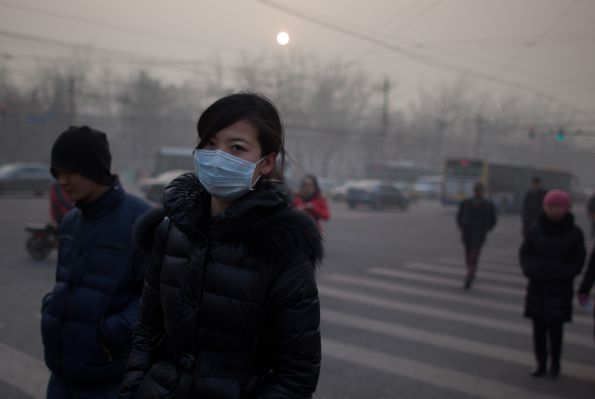(单词翻译:单击)
2013年1月15日雅思阅读精选:北京空气污染——最黑暗的一天(附参考译文)
From:The Economist, Jan 14th 2013, 4:49 by T.P. | BEIJING
Beijing's air pollution
Blackest day

ON January 12th of last year, in an article in the print edition of The Economist, we reported that the public outcry over Beijing’s atrocious air quality was putting pressure on officials to release more data about more kinds of pollutants. We also noted that Chinese authorities had already embarked on a wide range of strategies to improve air quality, and that they probably deserve more credit than either foreign or domestic critics tend to give them. But we concluded with the sad reality that such work takes decades, and that “Beijing residents will need to wait before seeing improvements.”
On January 12th of this year, Beijing residents got an acrid taste of what that wait might be like, as they suffered a day of astonishingly bad air. Pollution readings went, quite literally, off the charts. Saturday evening saw a reading of 755 on the Air Quality Index (AQI). That index is based on the recently revised standards of the American Environmental Protection Agency (the EPA), which nominally maxes out at 500. For more perspective, consider that any reading above 100 is deemed “unhealthy for sensitive groups” and that anything above 400 is rated “hazardous” for all.
Like many Beijing residents, your correspondent has mobile-phone apps that keep up with the pollution readings. At an otherwise pleasant Saturday-evening meal with friends, he joined his companions in compulsively checking for updates.
Those previously unseen numbers were hard to believe, but they did seem to match up well enough with the noxious soup we could see, smell and taste outside. We are all far more familiar with the specifics of air-quality measurement than we would like to be. Apart from the AQI readings above 700, we were quite struck to see the readings for the smallest and most dangerous sort of particulate matter, called PM 2.5, which can enter deep into the respiratory system. These are named for the size, in microns, of the particles. A reading at a controversial monitoring station run by the American embassy showed a PM 2.5 level of 886 micrograms per cubic metre; Beijing’s own municipal monitoring centre acknowledged readings in excess of 700 micrograms.
For perspective on that set of figures, consider that the guideline values set by the World Health Organisation regard any air with more than 25 micrograms of PM 2.5 per cubic metre as being of unacceptable quality.
Chinese authorities have complained about the American embassy's insistence on independently monitoring—and publicly reporting—Beijing’s air quality. And sometimes much is made of the vast differences between those readings and China’s own official ones, which are often less dire. Indeed, a key feature of one of those mobile-phone apps is the side-by-side comparison of those competing data-sets. (It is of course a bad sign that people here need more than one app to keep up with all this.)
But on a day like Saturday, the discrepancy between official readings and independent ones hardly seemed to matter; you didn't need a weatherman to know which way the ill wind blew. Or failed to blow, as the case may have been. One expert quoted by Chinese media attributed this spike in pollution to a series of windless days that allowed pollutants to accumulate.
But wind can be a problem when it does blow, too. In the outlying provinces that are part of Beijing’s airshed, there is a great deal of heavy industry. Pollution regulations are much harder to enforce there. And, in this colder-than-average winter, people have been burning more coal and wood than usual.
It is likely to be many more Januarys to come before China gets the upper hand on its air-pollution problems. Indeed, as we mentioned last January 12th, after nearly sixty years of trying and a vast amount of progress, the city of Los Angeles has yet to meet America's federal air-quality standards. If there is any consolation to what Beijing had to endure this January 12th, it is that it should lend urgency to the public outcry, and help speed things in the right direction.
The other consolation is that readings like the ones showing now on Monday midday (in the mid 300s, merely “hazardous” and “severely polluted”) feel fine by comparison.
(Picture credit: AFP)
参考译文:
北京空气污染——最黑暗的一天
去年1月12日,我们在印刷版的《经济学人》中报道了公众关于北京恶劣空气质量的呼吁迫使官方发布更多种类污染物数据一事。我们也注意到中国政府开始着手于采用多种策略来提高空气质量,因此他应该受到来自国外或者国内评论家更多的信任。但令人沮丧的现实是,这些工作需要花费数十年来完成,“在情况有所改观以前,北京居民还需等待些许时日。”
今年1月12日,北京居民的等待换来的却是辛辣的感觉,因为他们经历了空气质量出奇恶劣的一天。毫不夸张地,污染物读数飙升,超过了记录。星期六晚上,空气质量指数为755.这个指数是基于美国环境保护署最近修改的标准,名义上的最大值为500.有更多观点认为,指数只要高出100就会“不利于敏感人群的健康”,高出400的话,就会对所有人“有危险”。
像很多北京居民一样,我们记者的移动手机应用程序可以时刻更新污染指数。本应该是一次和朋友相聚其乐融融的周六晚餐,他却与同伴们不断地检查着数据的更新。
先前没有看到的那些数字有些难以置信,但是从我们看到闻到外面浓厚的毒雾来判断,应该也差不多。虽然我们不愿承认,但我们对测量空气质量的细节心知肚明。除了空气质量指数超过700之外,PM 2.5——空气中最小但最危险并可以进入呼吸系统的一种悬浮颗粒——的读数让我们十分震惊。它们是按照粒子微米下的体积来命名的。来自一座有争议的美国大使馆监测站的数据显示,PM 2.5的水平达到了886微克每立方米;北京市当地检测中心承认数据超过了700微克。
基于这一组数据,有观点认为,根据世界卫生组织指定的指导值,凡是PM 2.5高于25微克每立方米,即被认为是不能接受的空气质量。
中国官方一直就美国大使馆对北京空气质量坚持独自检测并发布表示抱怨。有时候,美国的指数会与中国官方的有很大差异,中国的通常会相对缓和一些。的确,移动手机应用的主要特征之一就是那些相互竞争的数据收集站的平行比较。(当然,这里的人们需要不止一个应用程序来更新这些数据,这并不是个好的现象。)
但是在这样一个星期六,官方的数据与独立监测站之间的差异也显得不重要了;你也不需要气象员来告诉你浑浊的气体是朝哪边吹的。或者说,事实上是根本没有在流动。引用中国媒体的报道,一位专家将这次污染指数爆表归罪于连续几天无风导致的污染物积聚。
但是当起风的时候,也会出现问题。在北京气流区域的边远省份有很多重工业。这些地区的污染管理更难实施。此外,在这个比平时要寒冷的冬季,人们烧了更多的煤和木柴。
看来,中国还需要很多年才能在空气质量问题上有所成效。确实,正如我们在去年1月12日提到的那样,洛杉矶通过大约六十年的努力和大量进展才达到了美国联邦空气标准。如果说对北京在这个1月12日必须承受的压力有些许安慰的建议,那就是北京应该更为紧迫地应对民众呼吁,并且促进事物往正确的方向发展。
另一个慰藉就是像星期一中午发布的指数(大概300过半,仅仅是“对人危险的”和“严重污染”)在相比之下就容易接受多了。(来源:译言网)


